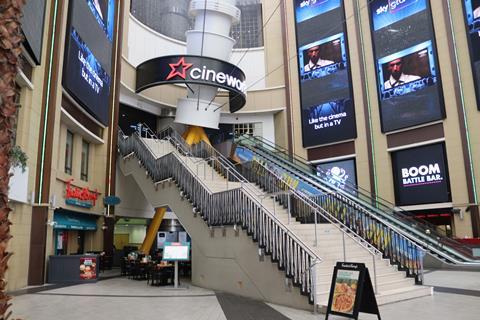
In late July 2024, debt-ridden cinema chain Cineworld confirmed it was “exiting” six of its 101 UK theatres while trying to reduce rent at many other locations. The sites include out-of-town facilities such as the seven-screen Glasgow Parkhead, with its 1,800 free parking spaces, and the six-screen Cineworld in Bedford’s Aspects leisure park (the other four are Hinckley, Loughborough, Yate and Swindon Circus).
Some analysts hope the theatres will be taken over by other operators, pointing out that 15 of the Empire chain’s 16 sites have reopened under new ownership, or are about to do so, since the chain went into administration last year.
Nonetheless, it was telling that Cineworld spoke of “increasingly high and unsustainable operating costs”. Between rent, energy and payroll, the venues it is quitting are dauntingly expensive to run. The circuit’s overall restructuring plan underlines a prevailing sense that the days of the giant multiplex may be coming to an end, and that UK exhibition is in the midst of its most dramatic metamorphosis in a generation.
According to the UK Cinema Association (UKCA) exhibitor trade body, the number of UK sites is falling, down from 878 in 2020 to 825 last year. UK cinema seats are also dropping, down from 937,161 in 2019 to 790,000 in 2022 — a 16% decline, in part a consequence of the trend to make screens and cinemas more luxurious. In 2017, there were 395 multiplex sites with an average of 8.9 screens each. But the size of multiplexes has been shrinking ever since.
“You see far fewer 10, 12 or 14-screen cinemas opening now,” acknowledges UKCA CEO Phil Clapp. “Certainly in the medium term, we are going to see a rationalisation of the number of cinemas [in the UK].”
The building of out-of-town locations has stopped entirely. “Just in terms of urban planning, encouraging people to get in their cars and head away from the town centre was a trend that wasn’t necessarily positive in terms of society and community,” adds Clapp. “It certainly wasn’t positive in terms of sustainability.”
Landlords themselves are sometimes declining to extend leases. Odeon has just closed its Covent Garden and Surrey Quays cinemas in London because of landlords’ redevelopment plans.
The familiar giants still dominate the UK and European exhibition landscape. Odeon, Cineworld and Vue International — with 2,409, 2,332 and 1,926 screens respectively across Europe — remain the three largest operators with a far bigger footprint than continental competitors such as Pathé Cinemas in France (1,259 screens) or Kinepolis in Belgium (668 screens). But all three are carrying significant debt loads and their business models are changing — they are looking to become leaner, more nimble and more attuned to what audiences now want.
Odeon — owned by troubled US giant AMC, which last month announced plans to defer debt repayments of more than $1.6bn over several years — has been rolling out more of its Luxe-branded cinemas, with new venues due to open this year in Peterborough, Norwich and Uxbridge. These sites emphasise comfort and luxury, with fully reclining seats, state-of-the-art projection and sound, and bar and café facilities.
Vue is also streamlining its sites. “With a modern estate, smaller footprints and landlords prepared to throw massive contributions towards refits, Vue is having a far better time and is not only now surpassing Cineworld on box office but is able to do so at far less cost,” observes one analyst.
Other operators are opening sites with fewer screens and setting aside space for alternative leisure activities. Light Cinemas, for example, offers bowling, karaoke, climbing and more alongside movies.
Evolving sector
Cinemagoing has changed since 1985, when AMC revolutionised the sector by opening The Point in Milton Keynes, a state-of-the-art venue that was hailed as the UK’s first multiplex. With its huge car park, The Point’s unique offer was that it could be reached easily by road from nearby Stevenage, Hatfield, Luton and Hitchin.
“While multiplexes have their detractors, without the multiplexes and the investment and economies of scale they brought, we would have been in a much worse place,” says Clapp of the role these sites played in lifting exhibition out of the doldrums of the mid-1980s when annual admissions had slumped to barely more than 50 million (they were at 124 million in 2023).
Today, it is debatable whether cinemagoers see drive times as a determining factor behind their film choices. “People want smaller cinemas they can walk to in their town centres, with comfy seating and ushers who look in on the screens and keep people quiet,” says exhibition specialist Neil Goulding, a former construction and facilities director at Empire Cinemas.
It is telling that in a UK exhibition market where many of its rivals are suffering (and complaining vociferously about lack of product since last year’s Hollywood strikes), Everyman Media Group is continuing to prosper. In late July, the cinema chain announced it had seen admissions rise 20% year-on-year and that revenues were up by 23% in the first half of 2024 — a period other operators openly called “horrific”.
The Everyman model is based around giving customers a luxurious experience in central high-street locations. “The Everymans have gone into spaces in towns that, pre-digital, they couldn’t have done. They were the quickest to explore different models,” notes exhibition veteran Mike Thomson, former director at Virgin, UGC Cinemas and Cineworld, and now a partner at leisure consultancy The Big Picture.
Other boutique operators such as Curzon and Picturehouse have also put an emphasis on comfortable seating and expansive food and drink options, although both of these chains are caught up in challenges facing their corporate owners — Cohen Media Group (CMG) and Cineworld respectively. (US-based real-estate developer CMG is in danger of defaulting on a $534m loan according to reports, with a US judge setting a November 8 auction date for CMG-owned properties that could impact Curzon’s future.)
The boutique circuits’ sleeker venues and customer service are in stark contrast to what is often on offer at some of the more decrepit multiplexes. “People are prepared to pay for a premium-service experience,” suggests Thomson. “They are no longer prepared to pay for something where they are just processed and there is no atmosphere. A lot of those out-of-town boxes fall into that category.”
Cinemagoing habits have also been evolving, fuelled by streaming and the shortening of theatrical windows. Films are quickly accessible on home-streaming platforms, so there is less need for multiplexes to keep them playing for weeks and months.
“I see a lot of first- and second-generation multiplexes built in the late 1990s or early 2000s that have not been invested in,” says Paul John Anderson, director of Omniplex cinema group, the ambitious Irish outfit that has established a foothold in the UK market by acquiring several Empire locations. “We like to do a face-lift every five years, and a full renovation every 10 years,” he adds.
In late summer 2024, as ticket sales surged on the back of Inside Out 2, Deadpool & Wolverine and It Ends With Us, optimism is growing that UK exhibition is again set to thrive. But that does not mean movie fans will continue to be bewitched by old-style multiplexes or drive to a vast hangar on the edge of town for the latest blockbuster.
Goulding uses the analogy of supermarket discount ranges: “The basic, Tesco-value multiplex doesn’t really have a place [anymore].”























No comments yet